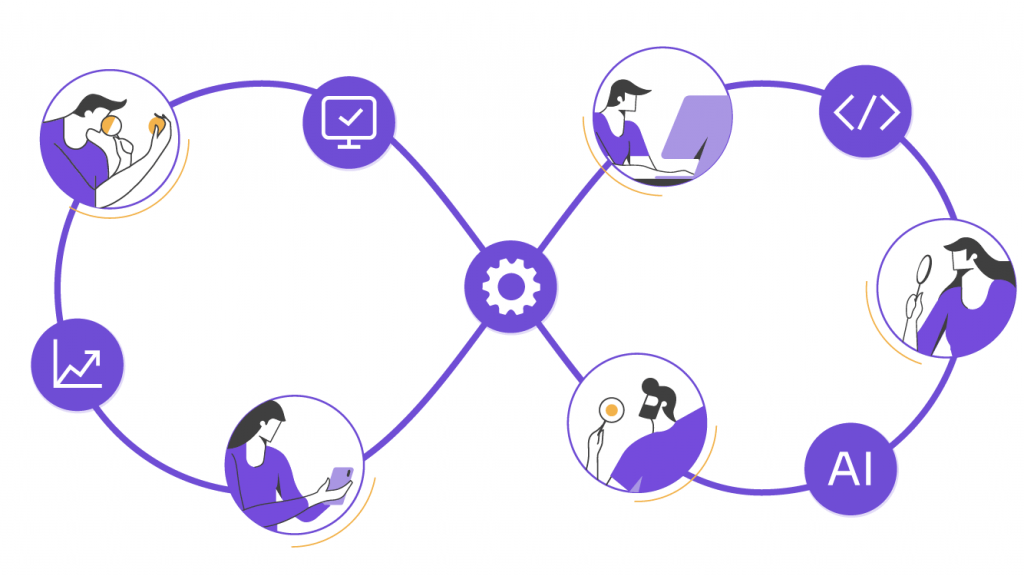What is Throughput? How is it calculated? Get to know real-world scenarios to gain a deep understanding and boost your software’s performance.


Have you ever wondered how many requests your sleek, new web application can handle during peak demand? That question introduces throughput, the measure of how much data or how many transactions a system successfully processes within a given timeframe.
Unlike raw speed, throughput reflects real efficiency under load, showing how well resources support scalability, responsiveness, and consistent user experience in demanding conditions.
Unleash Peak Performance – Transform your application with our tailored performance testing services!
What is Throughput?
Throughput is the amount of data or transactions a system processes within a defined time frame under specific conditions. It provides a direct measure of system capacity, helping evaluate efficiency, scalability, and stability across different workloads and contexts.
Different Contexts of Throughput
- Throughput in networking is the rate of data transmitted across devices within a defined period.
- Throughput in computing is the number of tasks, instructions, or transactions processed by a system under load.
- Throughput in storage is the data volume read or written per second from disks or cloud storage systems.
- Throughput in business is the speed at which products or services are delivered and converted into revenue.
Other contexts of throughput include logistics, telecommunications, and software systems, where it reflects efficiency in moving goods, transmitting signals, or executing transactions.
Throughput appears in different contexts, but its most actionable role is within software performance testing. In this domain, throughput measurement turns an abstract metric into a practical tool for assessing scalability, responsiveness, and efficiency under load.
What is Throughput in Performance Testing?
Throughput in performance testing is the number of requests or transactions a system processes per second under simulated workloads. This metric highlights system capacity, scalability, and responsiveness, helping identify bottlenecks and guide infrastructure optimization.
For instance, this could mean how many requests your web server processes or the amount of data transferred within a set timeframe.
Teams run throughput performance testing during a performance test run to track data processed, evaluate how many users the system supports, and confirm units processed or each data packet handled. These insights, supported by throughput metrics, help teams optimize network performance and strengthen scalability under real workloads.
Why Is Throughput Important in Performance Testing?
1. Data Handling
As applications grow, so does the data they manage. Knowing the throughput allows for better scalability planning, enabling your system to handle increased loads without faltering.
2. Consistent User Experience
If a system’s throughput is below what’s needed, users could face sluggishness, leading to frustration and potential churn. High throughput boosts a smooth and responsive experience for all users.
3. Optimizing Resources
By understanding this metric, organizations can optimize server and resource utilization, preventing both underuse and overburdening. This leads to cost savings and more efficient operations.
Let’s illustrate it! Imagine standing at the heart of a bustling city. The vehicles represent data, and the roads symbolize your application. Now, how many vehicles (data) can pass smoothly and efficiently on those roads (your application) without causing a jam? That’s throughput for you – a metric that doesn’t just count cars but allows the city to keep moving.
While it quantifies how many transactions or requests a server can manage within a specific timeframe, it’s more than just technical jargon. It reflects user satisfaction, system resilience, and software-hardware harmony.
So, why should all this matter to you? Simply put, because it directly impacts your business. High throughput means your application can serve more users simultaneously, enhancing their experience and consequently boosting your brand’s reputation and profitability.
The Big Picture: Throughput in the Grand Scheme of Performance Testing


Now, when you zoom out and look at the grand canvas of a performance test plan, the throughput doesn’t stand alone. It intertwines with other metrics like user load, response times, and system stability, painting a complete picture.
Throughput, while integral, is a part of a larger framework aiming to enhance application quality. Together with performance testing, user load, and other metrics, throughput helps systems aim for peak performance that aligns with real-user expectations.
Performance landscapes are ever-evolving. With every software update or server change, throughput might fluctuate. This dynamic nature highlights the need for regular performance tests to help applications adapt and deliver efficiently.
Throughput Test VS. Load Test
Load tests and throughput tests, while interrelated, serve different purposes within the broader scope of performance testing.
As already explained, a throughput test shows how much data the system processes and how efficiently it handles load. It provides a clear picture of the volume of transactions or requests handled, making it a key metric in high-traffic applications.
In contrast, often mistaken as the same concept as throughput testing, a load test assesses how a system performs under expected user loads, identifying its behavior and stability under normal and peak conditions.
This approach is pivotal when assessing system response times, especially as concurrent users increase. It provides insights into how well the system can accommodate the influx of users and maintain adequate response times.
Overall, while throughput tests are concerned with data transfer rates, load tests are crucial for understanding how well a system can maintain performance under stress. Both are different yet essential facets of the overarching performance testing process.
Empower your testing strategy with Abstracta Copilot, our AI-powered assistant. Achieve 30% more productivity while reducing costs and boosting quality.
Real-World Throughput Scenarios


What does throughput in performance testing look like in a typical test scenario? Imagine a web application that has to cater to thousands of concurrent users. The application meets the desired response times when the user load is low.
However, as more users access the web application, its behavior becomes inconsistent, leading to increased response times.
Performance goals may vary based on load conditions, the nature of web applications, and specific user profiles. Though goals vary, the objective is the same: an efficient user experience.
How is Performance Testing Throughput Calculated?
Performance testing throughput is calculated by dividing the total number of requests or transactions by the total time taken to process them. For example, 300 requests completed in 5 minutes equal 60 requests per minute, though factors such as server health, network speed, and request type can significantly influence results.
Example of How to Calculate Throughput in Performance Testing
During a load testing phase for an online shopping platform, suppose the system must handle 50,000 user requests during a peak sale. The initial tests indicate a throughput of 40,000 requests per hour, but after optimizations and load testing tool adjustments, the system improved to 52,000 requests per hour. This real-world scenario shows how throughput, combined with metrics like user profiles and transaction volumes, becomes invaluable for planning scalability and enabling a smooth user experience.
Key Challenges and Considerations
- Dynamic User Profiles: Real users might have varied behaviors. Some might perform data-heavy tasks, while others might make different requests, leading to fluctuations in system performance.
- Environment’s Throughput Upper Bound: Every environment has a maximum throughput it can handle. It’s important to understand this upper bound to avoid overloading the system.
- Variable Load Conditions: Throughput stays fairly consistent in steady states but can fluctuate during varying load conditions. Performance issues often emerge from the interplay between throughput and latency, especially under unpredictable spikes.
Industry Use Cases: Throughput in Action
Performance testing isn’t limited to consumer-facing platforms or digital products—it also applies critically to the software systems that power diverse industries, from logistics and finance to healthcare, retail, and technology. These systems often rely on real-time data flow across complex computer network infrastructures, making throughput a key performance metric.
Finances
In the financial industry, software must support high volumes of sensitive and time-critical operations, such as real-time trading, digital banking, and secure payment processing. These systems are mission-critical and must comply with strict security settings, all while minimizing delays in processing time to uphold user trust and regulatory standards.
Performance testing validates how many units (transactions or operations) the system can process and monitors throughput metrics to avoid system degradation during peak loads. Metrics are typically measured in requests per second to evaluate readiness for real-time markets.
We invite you read this article: Open Banking: The API Opportunity for Fintech and Banks
Healthcare
Healthcare systems operate under strict regulatory frameworks and real-time, high-stakes conditions. From electronic health records and lab data to telemedicine sessions and patient monitoring, each interaction depends on fast, accurate, and compliant data flow—often relying on secure transmission over complex transmission medium conditions.
A bottleneck or low throughput can delay treatments and affect outcomes. That’s why performance testing in health tech focuses on minimizing additional latency, detecting risks like packet loss and dropped packet scenarios, and tracking anomalies through robust error logging, especially in systems transmitting sensitive packet headers and header data.
Don’t miss this guide! Healthcare Software Development Solutions
E-commerce
In e-commerce, throughput directly impacts user experience and revenue. During high-demand periods like Black Friday, even slight delays can lead to abandoned carts or lost sales. Platforms must achieve high performance while handling processes like product search, checkout, and post-sale logistics. All this across both dynamic front-end systems and back-end integrations with multivendor environments.
Performance testing verifies that platforms can scale under pressure, whether it’s processing how many units per second at checkout or maintaining a stable response across the system. It also uncovers misconfigurations in application layer protocol behavior, supports a consistent throughput rate, and detects faulty hardware issues that might impact customer experience under load.
Tech
In tech environments, platforms often rely on complex infrastructures and multivendor environments to deliver features at speed. They demand consistent performance and a stable throughput rate, especially when releasing updates or deploying across distributed architectures.
Performance testing plays a key role in detecting latency issues, validating system scalability, and uncovering bottlenecks before they impact end users. In production, teams complement this with real-time monitoring and observability practices —including protocols like SNMP messages and tools such as Windows Management Instrumentation (WMI)—to enable ongoing system health and reliability.
They analyze backbone statistics, IP addresses, and system logs to improve protocol efficiency and maintain stability, essential for platforms operating across distributed architectures. This holistic approach also aids in preempting security incidents that could compromise performance or degrade user experience.
Manufacturing & Logistics
In logistics and supply chains, software systems mirror production processes and production cycle dynamics. Delays in sourcing raw materials or in data transfer between intermediate devices can affect operational continuity. Identifying and addressing bottlenecks in these environments helps to achieve more efficient data transfer and increase operational efficiency.
Teams focus on optimizing throughput and maintaining high throughput across environments that manage inventory, transportation, or order fulfillment—often relying on warehouse platforms and tracking systems that operate over wireless networks and other sensitive transmission paths.
These examples demonstrate how throughput testing adapts to the needs of each sector—reinforcing its central role in software quality engineering and business-critical performance assurance.
Take a look at our case studies and scale with confidence!
Contact us to optimize your software for any user load.
Interpreting The Performance Test Report


A comprehensive performance test report places throughput next to key metrics such as maximum concurrent users, network latency, and request anomalies. This allows teams to identify whether throughput drops are tied to spikes in user load or degraded network performance.
Within the context of throughput, the report might highlight periods where performance peaks, indicating optimal system performance, or valleys, suggesting bottlenecks or inefficiencies. Charts or graphs could display the flow of requests over time, illustrating the system’s consistency in processing requests.
This visual representation offers teams a glance at the behavior patterns during the test duration. Furthermore, potential correlations between other metrics like server resource consumption and throughput could be highlighted, demonstrating whether resource constraints affect the system’s ability to process requests effectively.
Additionally, testers may provide insights into specific events or triggers during testing that led to significant changes in throughput. This helps developers identify if certain features unexpectedly impact the system’s ability to handle data.
In a Nutshell


While being a pivotal metric in performance testing, throughout is just one part of a larger framework that seeks to enhance an application’s quality. Performance testing, user load, response times, and throughput goals work together to help a system perform at its peak and meet real user expectations.
On the whole, it’s crucial to remember that maintaining steady-state throughput is a continuous process. Every new release or change might impact the overall system performance, making regular performance tests critical for delivering an efficient, reliable, and scalable software application.
FAQs about Throughput in Performance Testing


What Is an Example of Throughput?
An example of throughput shows how many units a system processes per second, translating speed into measurable performance for data-heavy services. Consider a computer network where network devices handle network traffic at high performance while maintaining stable response times across applications.
How Do You Calculate Throughput?
To calculate throughput, divide total output by total processing time to derive a throughput rate at one point in the test window. Adjust for transmit time, round-trip time, and wait time, because several factors can skew results beyond simple averages.
How Do You Measure Network Throughput?
To measure network throughput, capture data transmission over time, and compare achieved rates, typically expressed against network bandwidth and network speed across the network infrastructure. Use simple network management protocol management information, SNMP messages, and Windows Management Instrumentation to analyze throughput across remote computer systems and validate protocol type configurations.
What Affects Network Throughput?
Network throughput is impacted by network latency, transmission medium quality, and storage delays, with computer and storage delays compounding hardware issues across the network infrastructure. Packet loss, malformed header data, and packet headers, and application layer protocol issues create additional latency and limit throughput, producing degraded network throughput under certain conditions.
What Is Throughput vs. Bandwidth?
Throughput vs. bandwidth clarifies that throughput refers to the actual amount of data delivered, while network bandwidth expresses theoretical capacity. Under identical links, maximum throughput may be lower than bandwidth due to protocol overheads and delays, making speed expectations differ from achieved performance.
How Does Higher Bandwidth Affect Throughput?
Higher bandwidth can support increasing throughput when throughput measures reveal capacity headroom and throughput metrics confirm efficient scaling across workloads. Optimizing throughput, improving throughput, and maintaining high throughput depend on end-to-end tuning, and high throughput ensures consistent experiences when upstream bottlenecks do not limit performance.
How Do Throughput, Network Performance, and Security Teams Interact?
Network and security teams collaborate to monitor throughput behavior and system behavior, correlating alerts with backbone statistics, network names, and host names. They apply practices like error logging and workflows to reduce risk from security incidents while coordinating guidance on protocol type.
Why Is Maintaining High Throughput Important for Companies?
Maintaining high throughput is important for companies because consistent capacity under load supports operational efficiency and predictable business outcomes. Across the production process, moving raw materials and units smoothly mirrors software pipelines, where reliable services and careful process control reduce costs and risk.
How Do Services Optimize Throughput for Operational Efficiency?
Services optimize throughput by coordinating application design with network infrastructure, tuning intermediate devices, and aligning security settings without disrupting compliance or reliability. Execution runbooks help teams measure throughput, minimize elapsed time, and coordinate changes to sustain performance without unexpected side effects.
How Does Improving Throughput Influence Business Performance?
Throughput improvements influence organizational performance by aligning data flows, process design, and network capacity so that high throughput supports predictable outcomes and reduces operational risk. For stakeholders asking what throughput is, treat it as achieved capability rather than a promise, because measure, bandwidth, and latency together determine sustainable outcomes.
How We Can Help You


With nearly 2 decades of experience and a global presence, Abstracta is a leading technology solutions company with offices in the United States, Chile, Colombia, and Uruguay. We specialize in software development, AI-driven innovations & copilots, and end-to-end software testing services.
We believe that actively bonding ties propels us further. That’s why we’ve forged robust partnerships with industry leaders like Microsoft, Datadog, Tricentis, Perforce BlazeMeter, Saucelabs, and PractiTest, empowering us to incorporate cutting-edge technologies. technologies.
Our holistic approach enables us to support you across the entire software development life cycle.
Visit our Performance Testing Services page and contact us to enhance your system’s performance!


Follow us on Linkedin & X to be part of our community!
Recommended for You
Volume Testing: How to Validate Systems Under Real Data Pressure
oque de script que se encuentra a continuación a la sección de encabezado de tu HTML:Tags In


Sofía Palamarchuk, Co-CEO at Abstracta
Related Posts
Developer’s friendly tools for continuous performance testing
How many times have we seen a test infrastructure and methodology where the team is not able to get early feedback about the performance of the system they are developing? Typically, it is expected to treat performance testing as a “waterfall project” where we, the…
WOPR29 is already here!
What will be the importance of performance testing in 5 years? The prestigious performance testing event WOPR29 is in full swing in Montevideo, and we interviewed a panel of experts to talk about this topic. They are Roger Abelenda, Andréi Guchin, Sofia Palamarchuk, Paul Holland,…
Search
Contents
Categories
- Acceptance testing
- Accessibility Testing
- AI
- API Testing
- Development
- DevOps
- Fintech
- Functional Software Testing
- Healthtech
- Mobile Testing
- Observability Testing
- Partners
- Performance Testing
- Press
- Quallity Engineering
- Security Testing
- Software Quality
- Software Testing
- Test Automation
- Testing Strategy
- Testing Tools
- Work Culture





